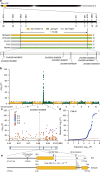A PECTIN METHYLESTERASE gene at the maize Ga1 locus confers male function in unilateral cross-incompatibility
- PMID: 30202064
- PMCID: PMC6131150
- DOI: 10.1038/s41467-018-06139-8
A PECTIN METHYLESTERASE gene at the maize Ga1 locus confers male function in unilateral cross-incompatibility
Abstract
Unilateral cross-incompatibility (UCI) is a unidirectional inter/intra-population reproductive barrier when both parents are self-compatible. Maize Gametophyte factor1 (Ga1) is an intraspecific UCI system and has been utilized in breeding. However, the mechanism underlying maize UCI specificity has remained mysterious for decades. Here, we report the cloning of ZmGa1P, a pollen-expressed PECTIN METHYLESTERASE (PME) gene at the Ga1 locus that can confer the male function in the maize UCI system. Homozygous transgenic plants expressing ZmGa1P in a ga1 background can fertilize Ga1-S plants and can be fertilized by pollen of ga1 plants. ZmGa1P protein is predominantly localized to the apex of growing pollen tubes and may interact with another pollen-specific PME protein, ZmPME10-1, to maintain the state of pectin methylesterification required for pollen tube growth in Ga1-S silks. Our study discloses a PME-mediated UCI mechanism and provides a tool to manipulate hybrid breeding.
Conflict of interest statement
The authors declare no competing interests.
Figures




Similar articles
-
Three types of genes underlying the Gametophyte factor1 locus cause unilateral cross incompatibility in maize.Nat Commun. 2022 Aug 3;13(1):4498. doi: 10.1038/s41467-022-32180-9. Nat Commun. 2022. PMID: 35922428 Free PMC article.
-
Pectin methylesterase activities in reproductive tissues of maize plants with different haplotypes of the Ga1 and Ga2 cross incompatibility systems.Plant Reprod. 2024 Dec;37(4):479-488. doi: 10.1007/s00497-024-00502-0. Epub 2024 May 3. Plant Reprod. 2024. PMID: 38700669 Free PMC article.
-
A single silk- and multiple pollen-expressed PMEs at the Ga1 locus modulate maize unilateral cross-incompatibility.J Integr Plant Biol. 2023 May;65(5):1344-1355. doi: 10.1111/jipb.13445. Epub 2023 Feb 17. J Integr Plant Biol. 2023. PMID: 36621865
-
Insights into the molecular control of cross-incompatibility in Zea mays.Plant Reprod. 2020 Dec;33(3-4):117-128. doi: 10.1007/s00497-020-00394-w. Epub 2020 Aug 31. Plant Reprod. 2020. PMID: 32865620 Review.
-
Using maize as a model to study pollen tube growth and guidance, cross-incompatibility and sperm delivery in grasses.Ann Bot. 2011 Sep;108(4):727-37. doi: 10.1093/aob/mcr017. Epub 2011 Feb 23. Ann Bot. 2011. PMID: 21345919 Free PMC article. Review.
Cited by
-
The cotton pectin methyl esterase gene GhPME21 functions in microspore development and fertility in Gossypium hirsutum L.Plant Mol Biol. 2023 May;112(1-2):19-31. doi: 10.1007/s11103-023-01344-6. Epub 2023 Mar 16. Plant Mol Biol. 2023. PMID: 36929454
-
Application of the maximum threshold distances to reduce gene flow frequency in the coexistence between genetically modified (GM) and non-GM maize.Evol Appl. 2022 Mar 11;15(3):471-483. doi: 10.1111/eva.13361. eCollection 2022 Mar. Evol Appl. 2022. PMID: 35386402 Free PMC article.
-
Transcriptome profiling of foxtail millet (Setaria italica) pollen and anther.BMC Plant Biol. 2024 Dec 20;24(1):1221. doi: 10.1186/s12870-024-05976-8. BMC Plant Biol. 2024. PMID: 39707174 Free PMC article.
-
Three types of genes underlying the Gametophyte factor1 locus cause unilateral cross incompatibility in maize.Nat Commun. 2022 Aug 3;13(1):4498. doi: 10.1038/s41467-022-32180-9. Nat Commun. 2022. PMID: 35922428 Free PMC article.
-
A toxin-antidote system contributes to interspecific reproductive isolation in rice.Nat Commun. 2023 Nov 18;14(1):7528. doi: 10.1038/s41467-023-43015-6. Nat Commun. 2023. PMID: 37980335 Free PMC article.
References
-
- United States Department of Agriculture Foreign Agricultural Service. https://www.fas.usda.gov/data/grain-world-markets-and-trade 2016.
-
- Nelson, O. E. in The Maize Handbook, M. Freeling, V. Walbot, Eds. (Springer New York, 1994), 496–503.
-
- Liu X, et al. Fine mapping of the maize cross-incompatibility locus using a homogeneous population. Crop Sci. 2014;54:873–881. doi: 10.2135/cropsci2013.09.0598. - DOI
Publication types
MeSH terms
Substances
Grants and funding
- 2016ZX08010-002/Ministry of Agriculture of the People's Republic of China (Ministry of Agriculture)/International
- 91535105 and 31271729/National Natural Science Foundation of China (National Science Foundation of China)/International
- 2016094 and 2017136/Youth Innovation Promotion Association of the Chinese Academy of Sciences (Youth Innovation Promotion Association, CAS)/International
LinkOut - more resources
Full Text Sources
Other Literature Sources
Research Materials
Miscellaneous

